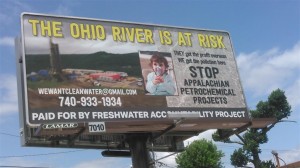.
From a Newsletter of the FreshWater Accountability Project, June 8, 2020
Last month FreshWater Accountability Project put up a Billboard in Moundsville to help protect the Ohio River Valley from petrochemical projects. FWAP hopes the billboard will raise awareness about projects that threaten the area and help people connect to one another to fight back to protect their environment and health.
The billboard will remain up for at least the next three months. In August, FWAP will also be sending a more detailed informational mailing to those living in the areas that will be most profoundly impacted by proposed petrohub projects.
FWAP has been and will continue to be aggressive in combatting all efforts to turn the Ohio River Valley into the next “cancer alley” through petrochemical development.
As background on the issue, in 2015, the governors of Ohio, West Virginia, and Pennsylvania signed the Tri-State Shale Coalition Agreement, a comprehensive plan committing the three states to work together to expand natural gas development in the Appalachian Basin.
As part of carrying out this plan, the three states are determined to build a new petrochemical corridor in the Ohio River Valley, which to date include at least the following projects:
§ — The Mountaineer NGL Storage Facility, a huge ethane storage cavern to be made from a former salt mine in Monroe County that will take enormous quantities of water from the Ohio River to dissolve salt to create storage room, creating huge storage lakes to hold the resultant 3.2 billion barrels of brine that would create a catastrophe if dams were breached during a flood event.
§ — The PTT Global Petrochemical Complex in Belmont County, Ohio (Dilles Bottom across from Moundsville, WV) — a huge multi-national scheme by South Korean and Thai chemical companies to take ethane to make plastics and chemicals and ship product mostly overseas. According to the Environmental Integrity Project, the initial air permit applications for the PTT project requested to emit up to 538 tons of carbon monoxide, 297 tons of Volatile Organic Compounds (some known carcinogens), and 1.6 million tons of CO2 equivalent (greenhouse gases) a year into the air, not to mention tons of other pollutants such as Nitrogen Oxides (a family of highly reactive, poisonous gases) and small particulate matter (which can cause severe health effects when inhaled). Now the project has grown larger, which means even more toxic pollutants will be requested to be permitted.
§ — The Falcon pipeline, a 98-mile pipeline designed to take ethane from our region to feed the Shell Petrochemical Plant in Monaca, PA to make plastics and chemicals. This pipeline passes near schools, day care centers, family homes, and through the watersheds of numerous drinking water sources. FWAP submitted comments with Sierra Club to Ohio EPA opposing the issuance of Falcon’s 401 certification.
§ — The huge Rover pipeline, made of two 42” high-pressure fracked gas pipelines to transport shale gas to overseas markets. Annual GHG emissions from the Rover pipeline alone are equivalent to 42 average U.S coal plants or over 30 million passenger vehicles (145 million metric tons).
These combined projects would support what is often referred to as the Appalachian Storage and Trading Hub, and much of the financing is coming from China Energy with loan guarantees of our tax dollars through the Department of Energy.
These projects stand to impact more than 400 miles of streams and rivers within the Ohio River basin and would encompass more than 50 counties in Pennsylvania, Ohio, and West Virginia.
Stay in touch for how you can help combat petrochemical projects in your communities, upcoming community meetings, and for updates on what FWAP is doing to defend Ohioans from these dangerous projects. And see above for our recent billboard!

